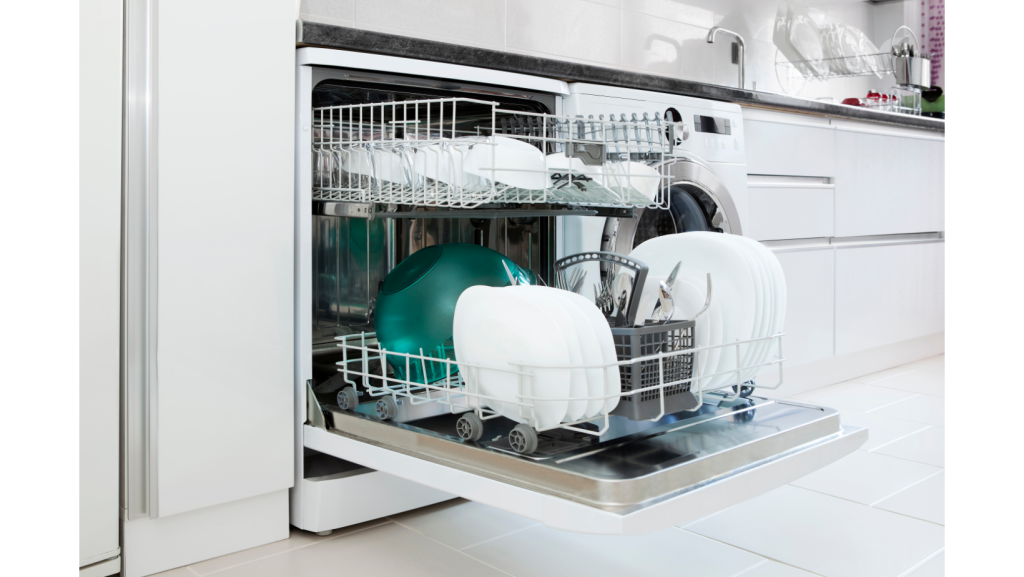Dishwashers are lifesavers when you’re too tired to scrub pots and pans. But what happens when your trusty sidekick starts acting up? Fear not; you’re just a few steps away from restoring it to its former glory! In this article, you’ll learn what makes a dishwasher tick and how to tackle some common issues. You’ll come away feeling like a DIY Rockstar.
What is a Dishwasher
A dishwasher is your modern-day kitchen knight in shining armor. With a mix of water, detergents, and sound old-fashioned engineering, it automates the washing and drying your dirty dishes, saving you time and energy.
Parts of a Dishwasher
Understanding the parts of a dishwasher will give you the upper hand in diagnosing problems.
1. Wash Arms: Rotate and spray water on the dishes.
2. Detergent Dispenser: Holds and releases detergent.
3. Racks: Where you place the dishes.
4. Heating Element: Heats water for cleaning and air for drying.
5. Control Panel: The “brain” behind the cycles.
6. Drain Pump: Removes water at the end of a cycle.
7. Spray Tower: Directs water spray to various parts of the dishwasher.
Basics of How a Dishwasher Works
Before diving into repairs, it helps to understand how a dishwasher works. Essentially, the cycle begins by filling the machine with water, which is then heated by the heating element. The wash arms spray hot water mixed with detergent over the dishes. The dirty water drains out, and a freshwater rinse takes place. Finally, the heating element dries the dishes. By knowing these basics, you’ll be better equipped to identify any potential issues.
Identifying Common Problems
A little hiccup is natural in the lifespan of any appliance. Here’s a guide to what might be ailing your dishwasher:
- Not Cleaning Well: Food bits still sticking?
- Not Draining: Water left at the bottom?
- Not Starting: A silent machine?
- Leaking: Puddles on the floor?
Warning
Before starting repair work, always unplug your dishwasher and turn off the water supply. Safety should be your top priority if you’re ever in doubt or dealing with electrical issues. Your safety is far more valuable than any cost savings from a DIY repair.
Ready, Set, Repair!
With a toolbox in hand and a can-do attitude, you’re already halfway there. The thrill of getting your hands dirty is exhilarating—let’s jump right in!

Not Cleaning Well
Believe it or not, you are overloading it. Too many dishes can block the water spray. If that’s not the case:
1. Check the Wash Arms: Remove, rinse, and replace.
2. Clean the Filter: Remove debris.
3. Inspect Detergent Dispenser: Make sure it’s not clogged.
Feel the euphoria as you load the dishwasher, which works like a charm!
Not Draining
A common issue but simple to solve:
1. Check the Drain Pump: Make sure it’s free of debris.
2. Inspect the Hose: No kinks or clogs.
3. Run a Vinegar Cycle: Sometimes, a good flush is needed.
Your heart will soar when you open the door and find it dry as a bone.
Not Starting
Before you panic, ensure it’s more complex than a disconnected plug or a switched-off outlet.
1. Examine the Control Panel: Any flashing lights?
2. Check Door Latch: A faulty latch can prevent starting.
3. Inspect Wiring: Always turn off the electricity first!
Hearing the hum of a working dishwasher will feel like a symphony.
Leaking
A puddle is not what you want to see. But keep calm; it’s usually a quick fix.
1. Check Door Seal: Replace if it’s worn.
2. Tighten Connections: Especially at the water inlet.
3. Inspect the Hose: Look for cracks or holes.
Mopping up that last puddle will feel like a victory lap.
Conclusion
You did it! The joy of repairing your dishwasher will leave you with a newfound sense of accomplishment. Next time it throws a tantrum, you’ll say, “Challenge accepted.” What’s more, you’ve gained knowledge, saved money, and extended the life of your trusty dishwasher.
Get ready to pop that celebratory dish into your revved-up dishwasher and bask in the glory of a job well done. Cheers to you, the household hero!

